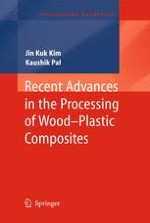2011 | OriginalPaper | Chapter
2. Surface Modifications in WPC with Pre-Treatment Methods
Authors : Jin Kuk Kim, Kaushik Pal
Published in: Recent Advances in the Processing of Wood-Plastic Composites
Publisher: Springer Berlin Heidelberg
Activate our intelligent search to find suitable subject content or patents.
Select sections of text to find matching patents with Artificial Intelligence. powered by
Select sections of text to find additional relevant content using AI-assisted search. powered by
